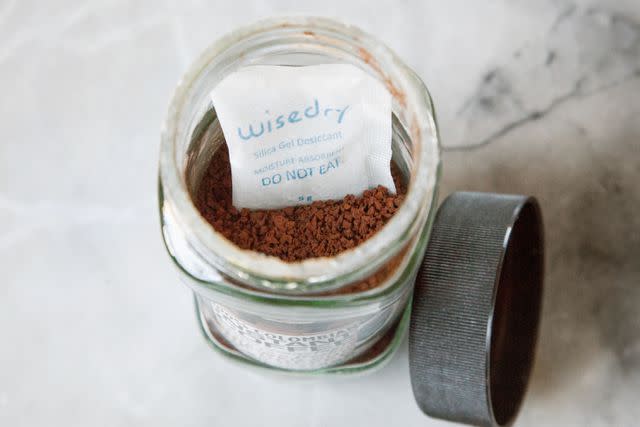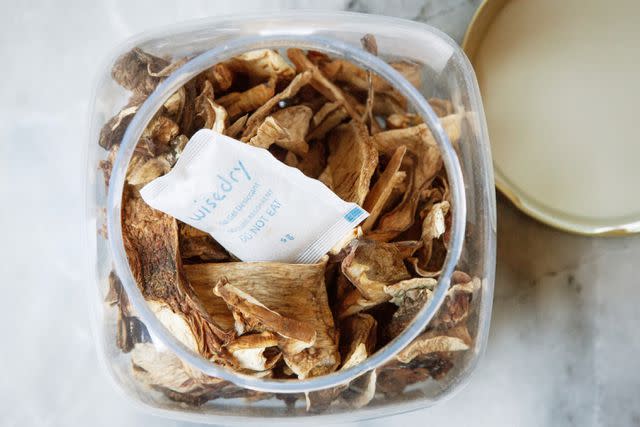Why You Should Keep Desiccants Packets in Your Kitchen
Dotdash Meredith and Yahoo Inc. may earn commission or revenue on some items through the links below.
You often get ‘em for free, but they’re actually pretty handy.

Serious Eats /
The weather in San Francisco is typically mild, but it can be oddly humid. Especially this year, where we’ve had a record 11 atmospheric rivers pass through (with more to come). This means it takes forever for dishes and kitchen towels to dry. And anything that's hygroscopic (something that absorbs moisture from the air or environment) will suck up water like a dry sponge. Thankfully, my husband, a chemistry professor, bought a bag of desiccant packets. I’ve been using them all over the kitchen.
Wisedry Food Grade Silica Gel Packs

What Are Dessicant Packets?

Serious Eats / Irvin Lin
Desiccant packets are those small rectangles you find in things like bottles of vitamins, shoe boxes, and bags of beef jerky. And while most folks just toss them, they’re extremely handy to have around, especially if you live in a humid environment.
Most gel desiccant packets are made of silica and can hold up to 35 to 40% of their weight in moisture. They’re hygroscopic (yes, I like that word) which means they attract moisture. This moisture-seeking property helps keep whatever they're stored with dry.
What Can Desiccant Packets Be Used for in the Kitchen?

Serious Eats / Irvin Lin
There are dozens of ingredients that are hygroscopic and sensitive to moisture, like espresso powder or instant coffee. Both are made by dehydrating pre-made espresso or coffee into a solid state, but the powder wants to be a liquid again. It’s hygroscopic and will suck moisture from the air like a sponge.
I use espresso powder to bake with whenever I make anything chocolate. A touch of coffee or espresso boosts the flavor of the cocoa, which is why it’s included in many brownie and chocolate cake recipes. But because I only use a couple of teaspoons at most per recipe, a jar of instant coffee can sit in the pantry for months. No matter how tightly I screw on the lid, the instant coffee grains always lump and solidify, making them unusable the next time I want to make chocolate mousse.
But once I started throwing a desiccant pack into my instant coffee powder, it started lasting a lot longer. Long enough for me to use the entire jar to bake with, which is pretty impressive.
Once I figured out that I could throw desiccant packets into ingredient containers, I started adding them everywhere. There’s a desiccant pack in my powdered sugar to help prevent clumping, in my box of kosher salt, and in my cocoa powder. I stick a packet in any dry ingredient that I think might clump together or get moldy, including dried mushrooms, panko and regular bread-crumbs, baking soda, freeze-dried fruit, bulk dried herbs and spices, and hard candy. Genevieve Yam, Serious Eats' culinary editor, has used desiccant packets in restaurants, too. "We basically used them to keep meringues and crispy things dry, and at the end of the night we would dehydrate the silica in a combi oven at like 100ºF," she says. "So we’d fill the bottom of a flat/wide container with the contents of a silica packet (we’d open it), line it/trap the silica with taped parchment, and then keep meringue pieces in the box. It would keep the meringues crisp."
The one clumping ingredient I wouldn't put a desiccant packet in, though, is brown sugar. Brown sugar clumps for the exact opposite reason that other ingredients like powdered sugar or instant coffee do. With the latter, moisture gets in, partially dissolves things, and clumping occurs. But because brown sugar is often white sugar processed with molasses, when the molasses loses moisture and dries out, it hardens. Adding a desiccant packet to brown sugar would just harden the brown sugar quicker.

Serious Eats / Irvin Lin
Beyond kitchen ingredients, wooden salad bowls or bamboo steamers get a couple of desiccant packets thrown into them when I put them away. The desiccant packets prevent moisture and potential mold from growing.
And one of the best things about the desiccant packets that my husband bought (from Wisedry) is that they have dyed pellets that change color as they absorb more water. Once they go from orange to green, you know the packet has absorbed as much water as it can. Microwave the packet for 30 seconds and the water will be driven off, making the packets usable again!
The one caveat (and it’s a big one) is clearly labeled on the packet itself: do not eat the packet! If you think the packet is broken or damaged, discard the entire content of the ingredients it’s sitting in or thoroughly wash the wooden or bamboo item. This scenario, by the way, has never happened to me, but it’s an important one to note. And if you have small children or someone who might mistake the desiccant packet as part of the food, you should probably avoid using it in your kitchen.
FAQs
Are desiccant packs poisonous?
Almost all desiccant packets are labeled with a “Do Not Eat” warning. But most desiccant packets are filled with silica gel, which is usually non-toxic, though occasionally they have a coloring agent like cobalt that is poisonous. That said, the silica gel pellets can be a choking hazard, especially for little kids. And if you ingest a large amount of the silica gel, it might cause an intestinal or bowel blockage which can be life-threatening. If you or someone you know has accidentally swallowed a desiccant packet or the contents of a desiccant packet, call 911 or seek medical attention immediately. For more information about the potential dangers of desiccant packets, visit this WebMD article.
Can you dry desiccant packs?
Yes. Most desiccant packs can be dried and reused. Some desiccant packs, like the WiseDry ones that I recommend above, have instructions on microwaving them, to heat them up and dry them out. But most other desiccant packs shouldn’t be microwaved, as that can overheat them. Only use the microwave method if the packet itself recommends it.
You can dry most other desiccant packs by placing them on an aluminum foiled lined baking sheet in a 250°F oven. Heat the packs for an hour to drive off the moisture. Let the packs cool to room temperature before using again or storing them in an air tight container.
Read More:We Tested 17 Kitchen Towels to Find the Best All-Purpose Ones

 Yahoo Autos
Yahoo Autos 